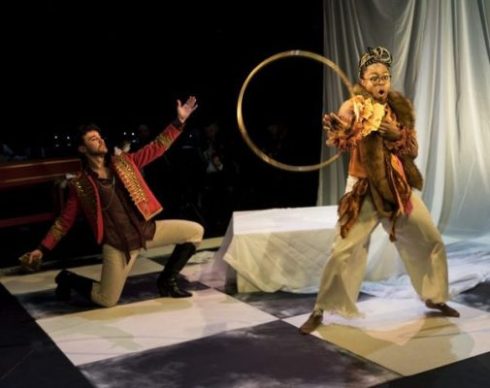 United Kingdom Purcell, The Fairy Queen: Soloists, HGO Antiqua Orchestra / Seb Gillot (conductor). Hampstead Garden Opera, Jackson Lane, London, 20.4.2024. (AK)
United Kingdom Purcell, The Fairy Queen: Soloists, HGO Antiqua Orchestra / Seb Gillot (conductor). Hampstead Garden Opera, Jackson Lane, London, 20.4.2024. (AK)

Production:
Director – Eloise Lally
Set and Costume designer – Elin Steele
Lighting design – Hector Murray
Choreography – Monica Nicolaides
Cast:
The Photographer – Hannah Jessop
Ensemble of singers – Issy Bridgeman, Emily Gibson, Daisy Livesey, Betty Makharinsky, Elspeth Piggott, Amy Kearsley, Richard Decker, Garreth Romain, Brennan Alleyne, Guy Beynon, Jack Harberd, James Holt, Chris Murphy, Allyn Wu.
In spite of being of a certain age and passionate about opera, I have never heard, let alone seen, Purcell’s The Fairy Queen. Usually described as a semi opera to accompany the delightful but complicated plot of Shakespeare’s A Midsummer Night’s Dream, my operatic path has not led me to it until now.
My knowledge of the plot originates from Britten’s opera A Midsummer Night’s Dream (1960) and the Ashton ballet titled The Dream (1964). Both masterpieces take Shakespeare’s comedy as their base and structure their music/movement around it.
Purcell did not set his music to Shakespeare’s text but, judging by the score, his five masques – including instrumental music, songs (with text by unknown librettists), dance and spectacles of various kinds – seem to complement it. Experts have been debating if Purcell’s contribution had any meaningful relationship to the play; formerly Hampstead Garden Opera, HGO’s staging added confusion to the debate.

In HGO’s production Purcell’s music is performed without the spoken text to which it was composed. The plot is presented as a dream (or a series of dreams) as well as aspirations of a photographer whose character is supposed to be based on war photographer Lee Miller (1907-1977). There is a division between the photographer and her dream figures: the photographer does not wear any costumes and does not sing while the cast of fourteen singers wear ever changing costumes / sing / dance and give it their all. I am not convinced by the alleged Lee Miller connection and found the presence of the photographer as confusing as superfluous, even though the production makes her the main protagonist.
The hard-copy programme notes, provided to the audience free of charge, are welcome but do not clear the confusion. They list all fourteen singers (and the photographer first in line) but it is hard to decipher who was which character: sometimes only their solo songs are specified, others are allocated to named characters. The names of specified characters are from Purcell’s opera which does indicate the intention to stay closer to Purcell than to Lee Miller.
The fourteen young singers selected for this HGO production were excellent; I would be happy to see any of them on any opera stage of the world. The had a hard task: apart from singing (solos and choruses), they were also the dancers in the great many dance numbers, and they were required to change costumes (without any help and in full view of the audience) on numerous occasions. Hats off to all fourteen singers!
Coming to the The Fairy Queen for the first time put me at a disadvantage to understand HGO’s storyline. However, in my defence, there was so much distraction on stage that the visual overtook the cerebral. The costumes were beautiful at times (plain white for the presumed Athenians) bewildering or super-camp elsewhere. The singers often were required to be camp, and they did indeed camp it up more than what I would have liked for Purcell’s music. Admittedly, the audience loved the entertainment.
Purcell was a Baroque composer and here we had an honourable and highly enjoyable baroque performance. HGO’s baroque singing and instrumental playing style would have been appreciated and approved by Purcell, whose wonderful music in this composition is full of varied instrumental numbers of his time. Dances and symphonic movements interact with the beautiful and witty vocal solos and choruses. For my taste, it was a shame to include a rendition of ‘YMCA’ (Village People) but it added to surprize and entertainment.
Of the great many excellent vocal numbers, I recall the witty dialogue between Coridon (a bass whom I cannot identify from the cast list) and Mopsa (Garreth Romain), the tenor Guy Beynon and first trumpet Katie Lodge dialogue (close to the beginning of Act V), the final trio (Act V) with two sopranos in excellent teamwork (presumably Emily Gibson, Daisy Livesey) and a bass (Allyn Wu).
Furthermore, I remain astonished by the exquisite performance of ‘The Plaint’, featuring soprano Betty Makharinsky and oboist Katie Lewis on conclusion of Act IV. Their duo was beautifully matched musically and dramatically, with the oboist playing from memory as well as physically following the soprano on stage. I still cannot understand how Katie Lewis managed to sit/kneel on stage and get up while playing her uninterrupted melodic line.
The talent on HGO’s stage was mesmerising.
Agnes Kory
